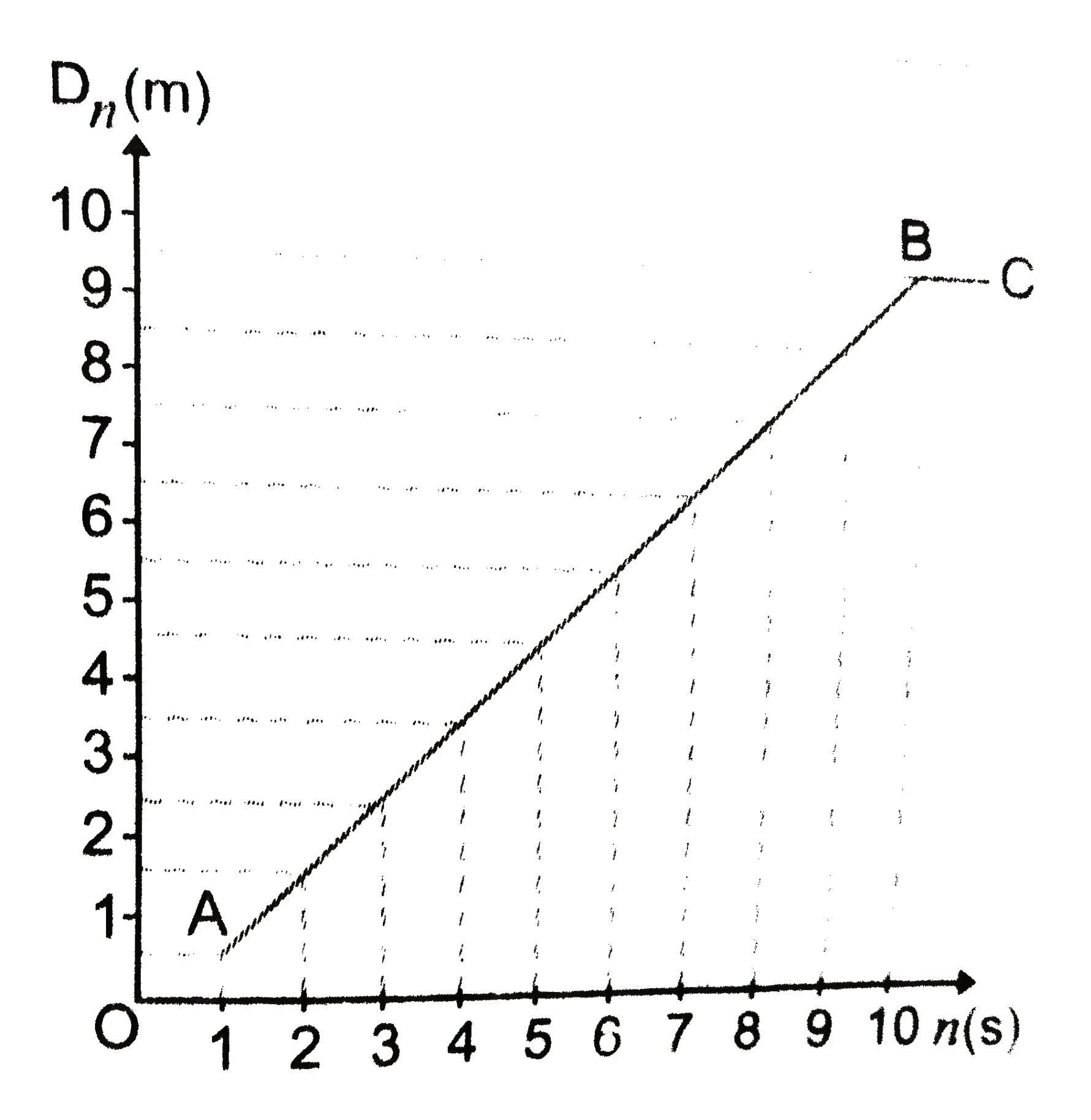A three wheeler starts from rest, accelrates uniformly with on a straight road for and then moves with uniform velocity . Plot a graph between the distance coverd by the vehicle during the nth second ( n = 1,2,3, ……..) v ersus (n) What do you expect the plot to be during acclerated motion: a straight line or a parabola ?
 .
.
Here,
Distance covered in nth second is
…(i)
Putting D_n D_n|{:(n,1,2,3,4,5,6,7,8,9,10),(D_(n),0.5,1.5,2.5,3.5,4.5,5.5,6.5,7.5,8.5,9.5):}| D_n nAB D_n prop n 10 s BC parallel to time axis.
Topper's Solved these Questions
- BOOK - PRADEEPCHAPTER - KINEMATICSEXERCISE - Motion25videos
KINEMATICS
- BOOK - PRADEEPCHAPTER - KINEMATICSEXERCISE - Higher order thinking skills14videos
KINEMATICS
- BOOK - PRADEEPCHAPTER - KINEMATICSEXERCISE - NCRT Exercises22videos
KINEMATICS
- BOOK - PRADEEPCHAPTER - GRAVIATIONEXERCISE - Assertion-Reason Type Questions19videos
GRAVIATION
- BOOK - PRADEEPCHAPTER - LAWS OF MOTIONEXERCISE - Assertion- Reason Type Questions17videos
LAWS OF MOTION
Similar Questions
Starting from rest a car accelerates unifromly with 3ms−2 for 5 s and then moves with uniform velocity. Drwa the distance-time graph of the motion of the car upto t = 7s.
View SolutionA body starts from rest and moves with a uniform acceleration of 10ms−2 for 5 seconds. During the next 10 seconds it moves with uniform velocity. Find the total distance travelled by the body (Using graphical analysis).
View Solution
Knowledge Check
- Question 1 - Select One
A car starts from rest and accelerates at a constant rate in a straight line. In the first second, the car covers a distance of 2.0 meters. How much additional distance will the car cover during the second second of its motion ?
A2.0 mB6.0 mC4.0 mD8.0 m - Question 2 - Select One
A particle moving in a straight line covers half the distance with speed v0. The other half of the distance is covered in two equal time intervals with speed v1 and v2, respectively. The average speed of the particle during this motion is
Av0(v1+v2)v0+v1+v2B2v0(v1+v2)v0+v1+v2C2v0(v1+v2)2v0+v1+v2Dv0(v1+v2)2v0+v1+v2
A particle starts from rest and moves along a straight line with uniform acceleration. The ratio of distance travelled by the particle during the first three seconds to the distance travelled by the particle during the next three seconds is 3 о 2
View SolutionA particle starts from rest and moves along a straight line with uniform acceleration. The ratio of distance travelled by the particle during the first three seconds to the distance travelled by the particle during the next three seconds is 3 о 2
View SolutionA car starts from rest and accelerates uniformly with 2 ms−2. At t = 10 s, a stone is dropped out of the window 1 m high of the car. What are the (i) velocity, and (ii) acceleration of the stone at t = 10.1 s? (Neglect air resistance). Take g = 9.8ms−2.
View SolutionA body starting from rest acclerates uniformly along a st. line , at the rate of 10ms−2 for 5 s.Itmovesfor2 swithuniformvelocotyof50 ms^(-1).Theitrηrdsuniformlyandcomes→rest∈3s. Draw velocity-time graph of the and find the total distance travelled by body.
View SolutionA body starts from rest at A and moves with uniform accelerationa in a straight line. T seconds after,a second body starts from A and moves with uniform velocity Kinthe same line. Prove that the second body will be ahead of the first for a time 2a√V(V−2aT)
View SolutionA particle is moving along a straight line with uniform retardation of 2ms−2 The initial speed of particle is 20m/s .The distance travelled by the particle during the last one second before it stops is
View Solution
